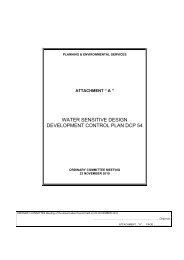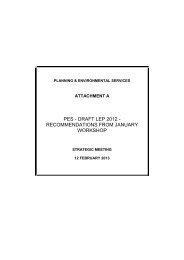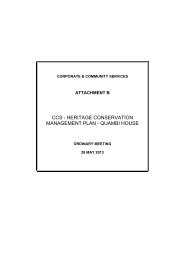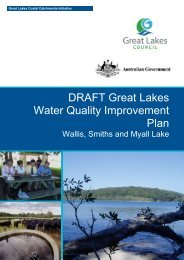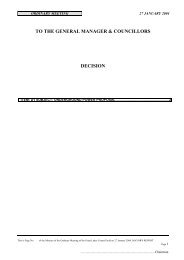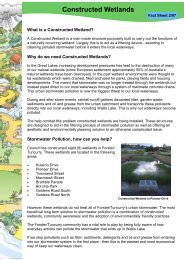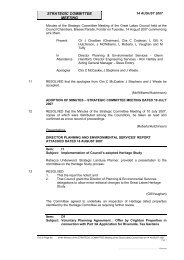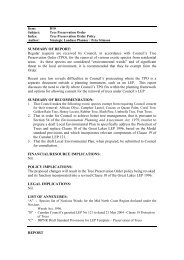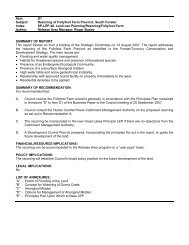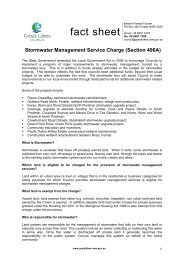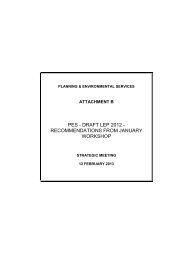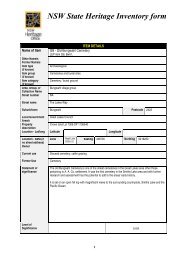smiths lake planning study volume 1: text - Great Lakes Council
smiths lake planning study volume 1: text - Great Lakes Council
smiths lake planning study volume 1: text - Great Lakes Council
You also want an ePaper? Increase the reach of your titles
YUMPU automatically turns print PDFs into web optimized ePapers that Google loves.
SOILS AND GEOTECHNICAL 10<br />
Bore<br />
The results of testing undertaken by Robert Carr & Associates Pty Ltd (RCA) as part of this<br />
<strong>study</strong> are presented in Table 2-4. This has involved Atterberg limit and linear shrinkage testing<br />
of clay samples as well as Emerson crumb tests to assess soil dispersion.<br />
Table 2-4 Atterberg Limit, Linear Shrinkage and Emerson Dispersion Class (RCA)<br />
Depth<br />
Soil Type<br />
Liquid<br />
Limit<br />
(%)<br />
Plastic<br />
Limit<br />
(%)<br />
Plasticity<br />
Index<br />
(%)<br />
Linear<br />
Shrinkage<br />
(%)<br />
Emerson<br />
Class<br />
(m)<br />
RCA3 0.5-0.6 Clay 63 15 48 4.7 5<br />
RCA6 0.25 Sandy clay 5<br />
RCA6 0.75 Silty clay 82 27 55 6.0 5<br />
RCA7 0.4-0.65 Sandy clay 5<br />
RCA7 1.0-1.1 Clay 14.3 5<br />
RCA10 0.4 Clay 8.1 5<br />
RCA12 0.2 Gravelly clay 10.6 5<br />
RCA15 0.3-0.4 Silty clay 5.1 5<br />
P17 Clay 5<br />
P18 Clay 5<br />
P19 Clay 5<br />
P20 Clay 5<br />
Figure 2-4 shows a plot of the Atterberg limits test results on the plasticity chart for classifying<br />
fine-grained soils by the Unified Soil Classification System. The Atterberg limits test results<br />
indicate that the clays would be generally classified according to the Unified Soil Classification<br />
System as clays of high plasticity (CH). The linear shrinkage results indicate that the clay soils<br />
are susceptible to <strong>volume</strong> change (shrinkage and heave) with variation in moisture content.<br />
The Emerson class numbers shown in Table 2-4 indicate that the clays and silts tested are nondispersive<br />
in nature. Dispersive soils contain clays that go into suspension in contact with water<br />
and are indicated by an Emerson class of 1 or 2.<br />
2.3.5 Erosion<br />
The magnitude of erosion that can occur at a particular location is dependant on the potential of<br />
erosive agents such as wind, rain and runoff to erode soils and the erodibility of the soil.<br />
Assessment of soil erodibility takes into consideration soil properties such as <strong>text</strong>ure, structure,<br />
dispersion, depth and infiltration and generally provide a general indication of relative<br />
resistance to water erosion.<br />
The Soil Conservation Service of NSW (Dyson, 1985) has noted that the soils in the general<br />
<strong>study</strong> area have a moderate to high erodibility. The soils are noted to be prone to sheet erosion<br />
once disturbed and the presence of locally dispersive subsoils has been noted in the soils<br />
developed on the Yagon Siltstone (Smiths Lake Village Area). Site specific soil profile<br />
assessment undertaken by the DLWC and shown in Table 2-2, confirms the moderate to high<br />
erodibility of the <strong>study</strong> area soils.<br />
The Emerson crumb dispersion test results indicate that the clay soils tested are non dispersive.<br />
This indicates that the erosive nature of the clay soils is related to soil structure and <strong>text</strong>ure<br />
SMITHS_LAKE_PLANNING_STUDY.DOC<br />
O C E A N I C S<br />
A U S T R A L I A




